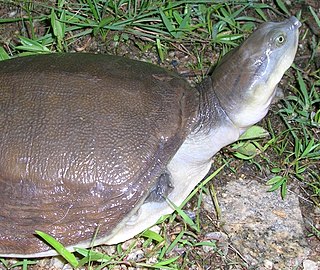
Pseudorca is a genus of cetaceans with three members which include Pseudorca yokoyamai, Pseudorca yuanliensis and Pseudorca crassidens, of which P. crassidens is the only extant member.

Carcharhinus is the type genus of the family Carcharhinidae, the requiem sharks. One of 12 genera in its family, it contains over half of the species therein. It contains 35 extant and eight extinct species to date, with likely more species yet to be described.

Lissemys is a genus of softshell turtles in the subfamily Cyclanorbinae of the family Trionychidae. The genus is indigenous to southern Asia.

Cycloderma is a genus of softshell turtles in the subfamily Cyclanorbinae of the family Trionychidae. The genus is endemic to Africa.
The North American land mammal ages (NALMA) establishes a geologic timescale for North American fauna beginning during the Late Cretaceous and continuing through to the present. These periods are referred to as ages or intervals and were established using geographic place names where fossil materials were obtained.
Batrachosuchoides is an extinct genus of prehistoric amphibian from the Early Triassic of Russia. It was found in the Baskunchakskaia Series and the Lestanshorskaya Svita.
The Deseadan age is a period of geologic time within the Oligocene epoch of the Paleogene to the Early Miocene epoch of the Neogene, used more specifically within the SALMA classification of South America. It follows the Tinguirirican and precedes the Colhuehuapian age.
The Laventan age is a period of geologic time within the Middle Miocene epoch of the Neogene, used more specifically within the SALMA classification in South America. It follows the Colloncuran and precedes the Mayoan age.
The Huayquerian age is a period of geologic time within the Late Miocene epoch of the Neogene, used more specifically within the SALMA classification. It follows the Chasicoan and precedes the Montehermosan age.

Coquimbo Formation is a Miocene to Middle Pleistocene sedimentary formation located in Coquimbo Region in Norte Chico, Chile. The lowermost unit belongs to the lower Miocene, with the third-deepest unit dated at 11.9 ± 1.0 Ma. The uppermost unit of the formation is estimated at 1.2 Ma. In the area of Tongoy, the Coquimbo Formation was deposited in an ancient bay that was formed in a graben or half-graben, with a normal fault dipping east. Sea level changes during the Holocene have caused erosion to cut several marine terraces into the formation.

Hyotheriinae was a subfamily of even-toed ungulates that existed during the Miocene and Pliocene in Europe, Asia, and Africa.

The Hiló Formation is a geological formation of the Altiplano Cundiboyacense, Eastern Ranges of the Colombian Andes. The predominantly shale formation dates to the Middle Cretaceous period; Late Albian to Early Cenomanian epochs and has a measured thickness at its type section of 470 metres (1,540 ft). The fossiliferous formation has provided a great abundance of ammonites and other marine species.

Boreostemma is an extinct genus of glyptodonts from northern South America. Fossils assigned to the genus were first described as belonging to Asterostemma from southern South America, but have been placed in the new genus Boreostemma by Carlini et al. in 2008. The type species is B. pliocena. Fossils of Boreostemma have been found in the Honda Group of Colombia, in Peru and Venezuela.

Miocochilius is an extinct genus of small notoungulate mammals (typotheres) native to South America. The genus lived during the Middle Miocene epoch. The genus contains two described species, the type species M. anomopodus described in 1953 by Ruben Arthur Stirton and M. federicoi, described and included in the genus by Darin A. Croft.









